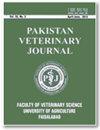求助PDF
{"title":"埃及Dakahlia省肉鸡生产链中沙门氏菌污染的追踪","authors":"M. Elsayed","doi":"10.29261/pakvetj/2019.038","DOIUrl":null,"url":null,"abstract":"Received: Revised: Accepted: Published online: November 26, 2018 January 04, 2019 January 07, 2019 March 16, 2019 The data available regarding the production chain particularly in poultry flocks in Egypt are yet to be fully elucidated. The study aimed at providing an insight into the cross-contamination with Salmonella spp. at three different stages of an integrated broiler production chain. From 440 collected samples, 152 (34.5%) were positive for Salmonella spp. corresponded to samples collected from broiler farms (n=90, 40.9%), slaughter houses contact surfaces (n=12, 24%) and chicken carcass (n=50, 29.4%) in an integrated broiler supply chain. Isolation and identification of salmonella spp. were followed the standard procedures. Genomic bacterial DNA was extracted and confirmed using specific oligonucleotide primers sequences. Salmonella strains were classified into 11 serotypes. Nine different serotypes were found to contaminate thebroiler houses and flocks with the most prevalent serotypes S. Enteritidis (38.8%), S. Kentucky (23.3%) and S. Typhimurium (11.11%). The overall frequency of Salmonella contamination in the live broiler flocks was 40.9% with prevalence of 37.9, 60, 40, 53.3, 60 and 20% from cloacae swabs, litter, feed, water, farms walls and in the hand swabs from workers, respectively. The PCR products of four isolates, (two isolates per S. Typhimurium and S. Enteritidis) were identified by DNA sequencing to determine the potential genetic relationships in these isolates. The findings of the present study suggested that different Salmonella serotypes can persist along the production chain and that contamination could be linked to the contamination of the final product with a potential health hazard to consumers. ©2019 PVJ. All rights reserved","PeriodicalId":19845,"journal":{"name":"Pakistan Veterinary Journal","volume":" ","pages":""},"PeriodicalIF":3.8000,"publicationDate":"2019-10-01","publicationTypes":"Journal Article","fieldsOfStudy":null,"isOpenAccess":false,"openAccessPdf":"","citationCount":"3","resultStr":"{\"title\":\"Tracing of Salmonella Contaminations Throughout an Integrated Broiler Production Chain in Dakahlia Governorate, Egypt\",\"authors\":\"M. Elsayed\",\"doi\":\"10.29261/pakvetj/2019.038\",\"DOIUrl\":null,\"url\":null,\"abstract\":\"Received: Revised: Accepted: Published online: November 26, 2018 January 04, 2019 January 07, 2019 March 16, 2019 The data available regarding the production chain particularly in poultry flocks in Egypt are yet to be fully elucidated. The study aimed at providing an insight into the cross-contamination with Salmonella spp. at three different stages of an integrated broiler production chain. From 440 collected samples, 152 (34.5%) were positive for Salmonella spp. corresponded to samples collected from broiler farms (n=90, 40.9%), slaughter houses contact surfaces (n=12, 24%) and chicken carcass (n=50, 29.4%) in an integrated broiler supply chain. Isolation and identification of salmonella spp. were followed the standard procedures. Genomic bacterial DNA was extracted and confirmed using specific oligonucleotide primers sequences. Salmonella strains were classified into 11 serotypes. Nine different serotypes were found to contaminate thebroiler houses and flocks with the most prevalent serotypes S. Enteritidis (38.8%), S. Kentucky (23.3%) and S. Typhimurium (11.11%). The overall frequency of Salmonella contamination in the live broiler flocks was 40.9% with prevalence of 37.9, 60, 40, 53.3, 60 and 20% from cloacae swabs, litter, feed, water, farms walls and in the hand swabs from workers, respectively. The PCR products of four isolates, (two isolates per S. Typhimurium and S. Enteritidis) were identified by DNA sequencing to determine the potential genetic relationships in these isolates. The findings of the present study suggested that different Salmonella serotypes can persist along the production chain and that contamination could be linked to the contamination of the final product with a potential health hazard to consumers. ©2019 PVJ. All rights reserved\",\"PeriodicalId\":19845,\"journal\":{\"name\":\"Pakistan Veterinary Journal\",\"volume\":\" \",\"pages\":\"\"},\"PeriodicalIF\":3.8000,\"publicationDate\":\"2019-10-01\",\"publicationTypes\":\"Journal Article\",\"fieldsOfStudy\":null,\"isOpenAccess\":false,\"openAccessPdf\":\"\",\"citationCount\":\"3\",\"resultStr\":null,\"platform\":\"Semanticscholar\",\"paperid\":null,\"PeriodicalName\":\"Pakistan Veterinary Journal\",\"FirstCategoryId\":\"97\",\"ListUrlMain\":\"https://doi.org/10.29261/pakvetj/2019.038\",\"RegionNum\":3,\"RegionCategory\":\"农林科学\",\"ArticlePicture\":[],\"TitleCN\":null,\"AbstractTextCN\":null,\"PMCID\":null,\"EPubDate\":\"\",\"PubModel\":\"\",\"JCR\":\"Q1\",\"JCRName\":\"VETERINARY SCIENCES\",\"Score\":null,\"Total\":0}","platform":"Semanticscholar","paperid":null,"PeriodicalName":"Pakistan Veterinary Journal","FirstCategoryId":"97","ListUrlMain":"https://doi.org/10.29261/pakvetj/2019.038","RegionNum":3,"RegionCategory":"农林科学","ArticlePicture":[],"TitleCN":null,"AbstractTextCN":null,"PMCID":null,"EPubDate":"","PubModel":"","JCR":"Q1","JCRName":"VETERINARY SCIENCES","Score":null,"Total":0}
引用次数: 3
引用
批量引用
Tracing of Salmonella Contaminations Throughout an Integrated Broiler Production Chain in Dakahlia Governorate, Egypt
Received: Revised: Accepted: Published online: November 26, 2018 January 04, 2019 January 07, 2019 March 16, 2019 The data available regarding the production chain particularly in poultry flocks in Egypt are yet to be fully elucidated. The study aimed at providing an insight into the cross-contamination with Salmonella spp. at three different stages of an integrated broiler production chain. From 440 collected samples, 152 (34.5%) were positive for Salmonella spp. corresponded to samples collected from broiler farms (n=90, 40.9%), slaughter houses contact surfaces (n=12, 24%) and chicken carcass (n=50, 29.4%) in an integrated broiler supply chain. Isolation and identification of salmonella spp. were followed the standard procedures. Genomic bacterial DNA was extracted and confirmed using specific oligonucleotide primers sequences. Salmonella strains were classified into 11 serotypes. Nine different serotypes were found to contaminate thebroiler houses and flocks with the most prevalent serotypes S. Enteritidis (38.8%), S. Kentucky (23.3%) and S. Typhimurium (11.11%). The overall frequency of Salmonella contamination in the live broiler flocks was 40.9% with prevalence of 37.9, 60, 40, 53.3, 60 and 20% from cloacae swabs, litter, feed, water, farms walls and in the hand swabs from workers, respectively. The PCR products of four isolates, (two isolates per S. Typhimurium and S. Enteritidis) were identified by DNA sequencing to determine the potential genetic relationships in these isolates. The findings of the present study suggested that different Salmonella serotypes can persist along the production chain and that contamination could be linked to the contamination of the final product with a potential health hazard to consumers. ©2019 PVJ. All rights reserved


